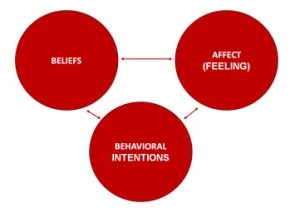Market research surveys reveal whether or not a company’s product or service offerings meet the customer expectations. When market analysts first recognize what consumers want in a specific product or service, they can construct a poignant and effective customer satisfaction survey. The survey’s outcome will serve as a template in transforming its brand. Based on these changes, marketing researchers and analysts will track the effects of the brand adjustments on the customer attitude as time progresses. Moreover, the data from the consumer research survey, which involves the customer attitudes and expectations, correlates with the customers’ purchasing behavior.
What are Customer Attitudes?
Customer attitude constitutes three components: cognitive information, affective information, and information relating to the customer’s previous behavior and prospective intentions. Basically, this composition includes thoughts, feelings, and behaviors about products or services that consumers have learned. A customer’s attitude differs in strength and depicts values.
Customer Attitude Models
Generally, there are two major attitude models: the tri-component model and Fishbein’s multi-attribute model. The tri-component model of attitudes illustrates that attitudes are composed of feelings, beliefs, and observable reactions. On the contrary, Fishbein’s multi-attribute model of attitudes considers that many factors influence attitudes.
What is Customer Expectation?
Customer expectation is a critical term in business and marketing. When there is forecasting, expectation ensues. It happens when an individual projects future events or proceedings and then anticipates for these forecasts to materialize. In consumer goods, customers have expectations on the products they purchase and services they avail. There are three kinds of expectations: meeting, exceeding, not meeting.
Meeting: Met expectations result in satisfaction.
Exceeding: Exceeded expectations result in delight.
Not meeting: Unmet expectations result in dissatisfaction.
Customer contentment and disappointment hinge on how valuable the product or service is. For instance, a consumer has a lot of expectations on a mobile company’s flagship smartphone. If the phone’s battery life won’t last long, the consumer will be dissatisfied. Further, if a phone’s camera can’t take good pictures, disappointment ensues.
 Expectation equates to hope. In other words, customers hope you will meet their expectations. If you fail to do so, their initial emotion is surprise, which is usually succeeded with anger.
Expectation equates to hope. In other words, customers hope you will meet their expectations. If you fail to do so, their initial emotion is surprise, which is usually succeeded with anger.
On the contrary, if you can surpass expectations, customers experience delight. When businesses make a promise, consumers expect it to happen. This applies especially when conducting marketing sales and making promises just so you can increase your sales. If the assurance was not fulfilled, this will be reflected in the company, thereby resulting in customer dissatisfaction.
What the customer believes is viable establishes the consumer’s expectation. Let us say that a customer who always makes online purchases usually receives his/her order in three days time. As a result, he/she now always assume that every time you make an online purchase, you will be able to receive your orders in as short as three days, regardless of whether or not the online retailer can fulfill this.
Types of Customer Expectations
Customer satisfaction reflects a customer’s expectations and experiences, either previous or current. Whenever we buy something, we either gather information from advertisements, test the product ourselves, consult are friends or families, and even study the product’s attributes. The data we collect affect how we create a product expectation. The type of these expectations will guide the structure and language of the questionnaires of a customer satisfaction survey. Therefore, it is a must that survey administrators get a good grasp of these types of expectations prior to actually gauging customer satisfaction.
Explicit Expectations – Include conceptual goals for a product’s performance.
Implicit Expectations – Illustrate the accepted benchmark for performance that businesses, industries, and society set.
Static Performance Expectation – Address performance metrics related to quality and efficiency, including reliability, customization, and timeliness, among others.
Dynamic Performance Expectations – Concerns expectations about the advancement or development of a product or service.
Technological Expectations – Directed on the progress of a product. For instance, the evolution of smartphones results in increased expectations of available features.
Interpersonal Expectations – Show the rapport that exists between the consumer and the product or service provider.
Situational Expectations – Considers certain conditions that result in satisfaction.
Why You Should Understand Customer Expectations
There are many reasons why businesses should study and understand their customer’s expectations. Through these, companies are able to determine which service levels will make customers happy and attain high customer satisfaction. It also creates an opportunity to surpass the expectations and aids in addressing customer complaints.
How Companies can Exceed Customer Expectations
There are four actions involved in creating a strategy that is aimed at exceeding customer satisfaction. These are managing, researching, reviewing, and supporting. Managing entails making choices about how to manage the emotional expectations of the customers. Researching refers to gathering and documenting information relative to the customers’ emotional expectations. Reviewing covers frequently reassessing and reevaluating their customers’ expectations since these expectations changes in time. Supporting means appropriating resources that will help the company’s team in realizing projects or actions that may surprise or please customers.
